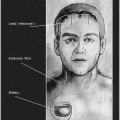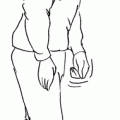and Kelvin L. Chou2
(1)
Parkinson’s Clinic of Eastern Toronto & Movement Disorders Centre, Toronto, ON, Canada
(2)
Michigan House, University of Michigan Medical School, Ann Arbor, MI, USA
Keywords
Parkinson diseaseCerebellar tremorDrug-induced tremorDystonic tremorEnhanced physiologic tremorFragile X associated tremor-ataxia syndrome (FXTAS)Holmes tremorPrimary writing tremorOrthostatic tremorPsychogenic tremorWilson diseaseMaking the Diagnosis
Several diagnostic criteria exist for the diagnosis of essential tremor (ET), but they are all similar [1–3]. All require the presence of an action tremor in both upper extremities (kinetic or postural) in the absence of other medical conditions or drugs that cause tremor.
On examination, patients should have an absence of other focal neurological findings except mild cogwheeling, especially in the elderly patients. Supportive (but not essential) features include positive family history of ET and tremor responsiveness to alcohol [1, 2]. Disease duration longer than 5 years without other neurologic signs also supports the diagnosis of essential tremor, but is not an absolute criterion [1, 2].
Features that would suggest another diagnosis for tremor include:
1.
Presence of abnormal focal neurological findings or sensory or motor signs, especially dystonia (abnormal postures)
2.
History of recent trauma before the onset of tremor
3.
History of factors that may cause enhanced physiologic tremor such as hyperthyroidism
4.
History of sudden onset or stepwise progression of tremor
5.
Presence of wide variability in tremor frequency, give-way weakness, entrainment or distractibility (suggesting psychogenic tremor)
6.
Tremor affecting only the legs (might suggest primary orthostatic tremor or Parkinson disease)
7.
Isolated voice tremor
8.
Isolated position-specific or task specific tremor (such as primary writing tremor).
9.
Unilateral tremor of prolonged duration, unilateral leg tremor, gait dysfunction, resting tremor, bradykinesia or rigidity.
10.
History of antipsychotics/antiemetics or other drug use that might cause or exacerbate tremor
Differential Diagnosis
One of the main concerns for patients who present to the clinic with a complaint of tremor is Parkinson disease, so this entity will be discussed first. With a careful history and examination, however, one should be able to distinguish ET from Parkinson disease fairly easily. (See Table 4.1 for a comparison of tremor features between ET, Parkinson disease, and enhanced physiologic tremor.) The rest of the differential diagnosis for ET includes (in alphabetical order) cerebellar tremor, drug-induced tremor, dystonic tremor, enhanced physiologic tremor, Fragile X associated tremor-ataxia syndrome (FXTAS), Holmes tremor, primary writing tremor, orthostatic tremor, and psychogenic tremor. Wilson disease would be a consideration in patients under the age of 40.
Table 4.1
Comparison of enhanced physiological tremor, ET and Parkinson disease tremor
Enhanced physiological tremor | Essential tremor | Parkinson disease | |
|---|---|---|---|
Common body parts affected | Hands | Hands, head, voice | Hands or arms, legs, chin |
Accompanying symptoms | None or symptoms of anxiety state | None | Rigidity, bradykinesia and postural instability |
Frequency | 10–14 Hz | Mainly 7–10 Hz (but may range from 4 to 12 Hz) | 3–6 Hz |
Positional component | Posture > Kinetic | Kinetic > posture, may have a slight resting component if severe | Resting (may have a postural/kinetic or re-emergent component in severe cases) |
Symmetry | Bilateral, symmetric | Bilateral, can be mildly asymmetrical | Initially unilateral, bilateral and asymmetrical in advanced stage |
Course | Usually non progressive | Progressive | Progressive |
Response to alcohol | Minimal or none | Responds significantly | None |
Effect of caffeine, stress, stimulants | Increases | Increases | Increases |
Inheritance | None | Autosomal dominant with variable penetrance | Sporadic or related to genetics of Parkinson disease |
Parkinson Disease
Parkinson disease tremor classically presents as a resting tremor in a limb. The tremor diminishes with activity and posture. The frequency of Parkinson disease tremor is in the range of 3–6 Hz [4]. In the hands, the tremor is typically characterized as pill-rolling (a pronation-supination movement of the wrist) [5]. Tremor in Parkinson disease typically starts unilaterally, in the hand or arm [6]. The tremor may also progress to involve the legs, and chin/lips but usually does not involve the head or voice. This type of tremor should be accompanied by other signs of Parkinson disease such as bradykinesia, rigidity and in more advanced cases, postural instability [5]. History of the other features of Parkinson disease such as drooling, difficulty with dexterity and micrographia (see Fig. 4.1) may be elicited.


Fig. 4.1
Multiple loops and handwriting sample of a Parkinson disease patient with micrographia (Today is a sunny day in Toronto)
Up to 93 % percent of patients with Parkinson disease may have action tremor in addition to the typical resting tremor though the action tremor typically occurs in combination with resting tremor and is much less noticeable than the resting tremor [7, 8]. Some Parkinson disease patients may have a re-emergent rest tremor. This is a postural tremor of the hands that appears with a several second latency after the hands adopt the outstretched position and has a frequency typical of the rest tremor in PD [8]. The postural tremor in ET appears immediately with upon adopting the outstretched posture position. It is an important distinction as the re-emergent rest tremor in PD may be mislabelled as an action tremor [9]. Parkinson disease is treated with dopaminergic medications.
Cerebellar Tremor
Cerebellar tremor causes a slow, coarse oscillation of the limbs at a frequency of approximately 3–5 Hz in a horizontal plane [2]. The tremor in the limbs is generated proximally. Tremor of the head and trunk may be caused by midline cerebellar lesions. It is not a true tremor because in most cases it is ataxia of the affected limb or body part. Patients often complain of limb incoordination and gait imbalance. On exam, abnormal finger-to-nose or heel-to-shin testing, dysarthria, and a wide-based ataxic gait may be seen. Common acquired causes of cerebellar tremor include multiple sclerosis, head trauma, stroke, or cerebellar haemorrhage. A family history of cerebellar ataxia may suggest a genetic cause [10]. Cerebellar tremor is extremely difficult to treat.
Stay updated, free articles. Join our Telegram channel

Full access? Get Clinical Tree






